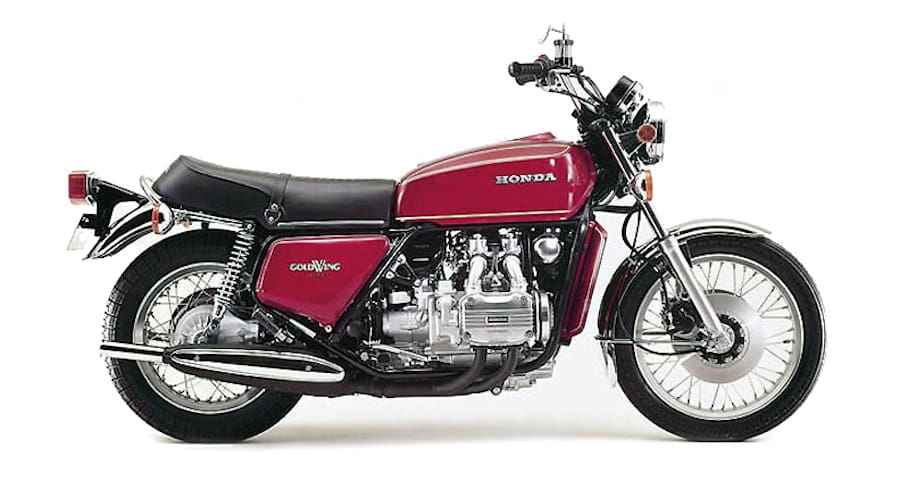Honda’s ST1300 had big boots to fill when it took over ‘Big Red’s’ magnum sports-tourer role from the ST1100. But it was well up to the task.
Its alloy beam-frame is lighter and stiffer than the 1100’s tubular-steel version. While the new 1261cc version of the liquid-cooled V4 engine shared its basic architecture with its 1084cc predecessor, much of it is new. Electronic fuel injection replaces carburettors. Cam-drive changes from belt to chain. Twin balancer shafts enable the much smoother engine to be a rigidly mounted chassis component. As with the ST1100 a five-speed gearbox and shaft final-drive completes the ST1300’s drivetrain.
The ST1300 rides on 45mm non-adjustable forks and a pre-load adjustable monoshock – unremarkable, but very effective kit.
The full touring-fairing and electrically-adjustable screen provide excellent protection from wind and weather. It can get a bit toasty in the cockpit, though, if you’re stuck in city traffic on a summer’s day.
The hard panniers offer secure, weatherproof luggage space. There’s heaps of room for rider and passenger on the comfortable seat. It accommodates a wide range of rider shapes and sizes in a relaxed touring posture.
A nice touch is the ‘tip-over’ protection against damage from stationary or walking-pace drops provided by reinforced fairing ‘wings’. Incidentally the big Honda is surprisingly easy to handle in tight, feet-up, walking-pace manoeuvres thanks to the combination of low-set weight and the smooth and predictable throttle and clutch action. Although the gearshift action of the heavy-duty gearbox isn’t exactly slick, it changes gear accurately and easily.
While the torquey 93kW (125hp) engine is as docile as you like around town, it can launch the big 289kg (dry weight) machine toward the horizon with remarkable rapidity when given its head. In that mode, despite the subdued exhaust note, the engine produces a fierce growl from the induction system – providing an enjoyable counterpoint to the bike’s overall ‘gentleman’s touring-express’ character.
A pair of 310mm front discs coupled to a 316mm rear disc provides excellent braking. ABS was available (ST1300A model) from 2003 and across-the-board from 2005.
Analogue speedo and tacho are first class – the subsidiary digi-displays can be hard to read in direct sunlight, though.
The bike’s intended playgrounds were the autobahns and autostradas of Europe where speed limits demonstrate respect for the judgement and skills of motorists. ST1300 owners from Britain and northern Europe are able to safely and comfortably match the pace of Ferraris and Porsches on the summer-holiday dash toward the Mediterranean.
Here that performance translates into absolutely drama-free interstate touring with the tacho showing a lazy 3700rpm in top at 110km/h, a speed that delivers a safe touring range of close to 550km from the 29-litre tank. Some die-hard ST1300-mounted Aussie touring-folk speak of taking 1200km days in their stride.
In twisty territory the big ST’s compact wheelbase and responsive steering geometry make it surprisingly agile – it drops readily and obediently into bends and corners predictably. UK reports of some STs fitted with hefty rear-mounted police equipment developing a dangerous weave above 170km/h have little bearing on use in these parts – as well I’m aware of ‘test pilots’ here who’ve pushed ST1300s with full luggage loads to significantly higher velocities with no ill effects (all in the interests of science and road safety, of course).
Following the end of the ST1300’s model-run some of its DNA survives in Honda’s CTX1300 ‘bagger-style’ cruiser.
With proper maintenance the ST1300 is pretty much indestructible – you hear of healthy examples with well over 200,000km on the clock that have only required routine servicing.
If you’re comfortable with big bikes and you like to cover lots of territory on stress-free interstate rides, a Honda ST1300 is worth a serious look.
PRICE GUIDE
New Price
$22,990 (2002) $24,690 (2012)
Second-Hand
$7100– $18,700
WHAT TO LOOK FOR
The ST1300 is Honda-robust and Honda-reliable. As always check for damage and signs of neglect and also factor in the cost of consumables like tyres, brake pads and brake rotors that will soon need replacing. Award extra points for an example featuring ABS.
For 2008-10 bikes check that rear brake-reservoir hose re-routing that was the subject of a safety recall has been carried out
A good service record can be more important than the particular bike’s age or kilometres.
BUILDING BRICKS
Honda GL1000
1975 – Honda makes its entry into the shaft-drive business with the release of its first Goldwing sports-tourer powered by a flat-four boxer engine with belt-driven cams.

Honda CX500
1978 – In the CX500, Honda combines shaft-drive with an across-the-frame V-configuration engine, in effect a compact version of the basic architecture of the ST 1300 model to come.

Honda ST1100
1990 – Honda’s introduction of the ST1100 provides a plausible Japanese competitor to BMW’s K100LT in the four-cylinder, shaft-drive sports-tourer category, paving the way for the ST1300.

SERVICE HISTORY
The ST1300 is a reasonably straightforward motorcycle for routine servicing by capable DIY owners. However access to the mechanicals requires the removal of numerous plastic fairing panels which should be handled with great care to avoid cosmetic damage to bodywork.
The interval for normal services is 12,000km. Majors at 24,000km intervals, that include shim-type valve-clearance work and sparkplug replacement, are best left to professionals by all but the most experienced DIY owners.
WORDS ROB BLACKBOURN











